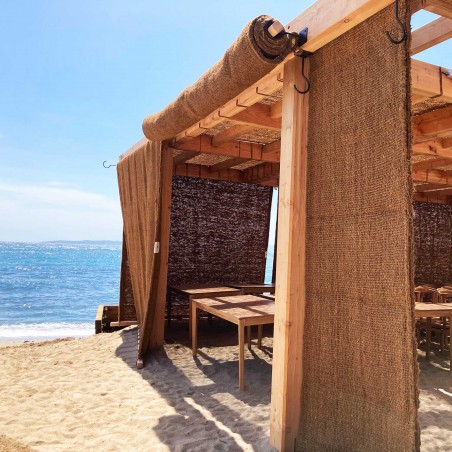

































































Simple, non-reinforced weaving for pergolas, curtains, and privacy screens. With the fine coir rope provided, you can set up the fixation points yourself.
The size chosen must be equal to or larger than the size of your structure (outer edge).
The shade sail weaving sifts the sun’s rays. It is weatherproof, rot-resistant, and very sturdy. It allows air to pass through for a fresh and pleasant feeling.
For this design, we provide free fine ropes (diameter 0.5 cm) so that you have enough to attach your shade sail to your fixed structure. If you want additional ropes or a different diameter, don’t forget to select some when finalizing your order.
Shade sails weigh 1.2 kg per m2 and double in weight when wet. Thanks to their spaced-out weaving, they dry very quickly. Coconut fiber becomes slack once it is wet, and this feature reverts when it dries up; it’s how coconut fiber reacts to humidity. It may be necessary to slightly stretch your shade sail after the first rains, especially the large sails and/or when they’re attached with coir rope.
RECOMMENDATION BEFORE PLACING THE SHADE SAIL
We strongly advise you to rinse your sail shades and attachment rope with running water (on gravel or lawn, for example) and then let them dry before installation.
Repeat the operation if necessary.
This will minimize the deterioration that can cause, in some cases, the natural tannins of the coconut fiber.
Coconut fibers, like wood, are a natural material based on cellulose. When exposed to sunlight, they naturally undergo a color change, often turning into a grayish-brown tone. The primary factor causing this fading is the sun's ultraviolet (UV) radiation, which negatively affects natural fibers, including coconut.
Over time, continuous exposure to UV rays breaks down the pigments that give coconut its brown color, leading to a gradual faded appearance. This process is entirely normal and unavoidable for materials like coconut fibers, which are based on natural substances.
We avoid using chemical dyes or other additives to prevent fading in our products, as we believe in preserving the natural texture and appearance of the materials we use.
Simple, non-reinforced weaving for pergolas, curtains, and privacy screens. With the fine coir rope provided, you can set up the fixation points yourself.
The size chosen must be equal to or larger than the size of your structure (outer edge).
The shade sail weaving sifts the sun’s rays. It is weatherproof, rot-resistant, and very sturdy. It allows air to pass through for a fresh and pleasant feeling.
For this design, we provide free fine ropes (diameter 0.5 cm) so that you have enough to attach your shade sail to your fixed structure. If you want additional ropes or a different diameter, don’t forget to select some when finalizing your order.
Shade sails weigh 1.2 kg per m2 and double in weight when wet. Thanks to their spaced-out weaving, they dry very quickly. Coconut fiber becomes slack once it is wet, and this feature reverts when it dries up; it’s how coconut fiber reacts to humidity. It may be necessary to slightly stretch your shade sail after the first rains, especially the large sails and/or when they’re attached with coir rope.
RECOMMENDATION BEFORE PLACING THE SHADE SAIL
We strongly advise you to rinse your sail shades and attachment rope with running water (on gravel or lawn, for example) and then let them dry before installation.
Repeat the operation if necessary.
This will minimize the deterioration that can cause, in some cases, the natural tannins of the coconut fiber.
Coconut fibers, like wood, are a natural material based on cellulose. When exposed to sunlight, they naturally undergo a color change, often turning into a grayish-brown tone. The primary factor causing this fading is the sun's ultraviolet (UV) radiation, which negatively affects natural fibers, including coconut.
Over time, continuous exposure to UV rays breaks down the pigments that give coconut its brown color, leading to a gradual faded appearance. This process is entirely normal and unavoidable for materials like coconut fibers, which are based on natural substances.
We avoid using chemical dyes or other additives to prevent fading in our products, as we believe in preserving the natural texture and appearance of the materials we use.